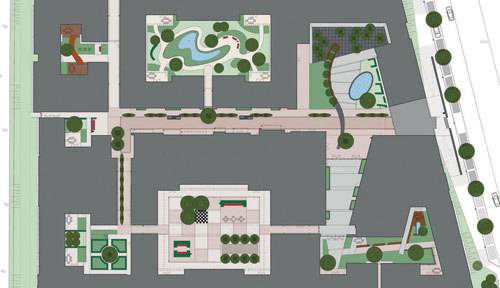Being safe doesn’t have to mean feeling restricted. Proof of just how true that is can be found in a unique village in The Netherlands called Hogeweyk.
The resident villagers are a select group: All 152 of them share a diagnosis of severe dementia or Alzheimer’s disease. And because they live in Hogeweyk, they enjoy freedom far beyond what’s customaryÑfreedom made possible by extraordinarily comprehensive security measures.

Attractive, individualized two-story homes line the perimeter of the village, a space about the size of 10 football fields (
see rendering, right). This perimeter is solid except for a single door, which is the only way in or out of the village. Inside that perimeter is a network of several streets along which are gardens, courtyards, and small parks overlooked by more homes.
Within walking distance from anywhere in the village are numerous amenities such as would be natural in a village: a post office, supermarket, cafe, theater (where plays and concerts are staged), restaurant, and town square large enough to host all kinds of social gatherings. The only difference is that the groceries, theater tickets, and restaurant meals are there for the asking. Managing finances is beyond most people whose dementia has reached this stage, so at Hogeweyk residents never have to handle currency. The cost of these goods and services is included in the family’s payment plan.
The cost of care is about $8,000 a month, which the Dutch government partially subsidizes, depending on the family’s income. Families never pay more than $3,600.
Finding A Resident’s Comfort Zone
Six or seven residents live in each of the 23 homes, assisted by one or two caretakers. The homes are furnished in the style of the 1950s, 1970s, or 2000s, and residents live in whichever style best reflects the time period they remember most clearly. The residents manage their own homes, such as the washing and cooking, with the help of staff.
The homes are organized into seven neighborhoods, each with its own lifestyle themeÑartisan, homey, urban, upper class (called Goois in Hogeweyk), Indonesian, cultural, and ChristianÑto which each environment is tailored. Homes in the artisan neighborhood, for example, have artwork everywhere, and music is always playing in the background. Based on pre-admission interviews with the resident and family that elicit not just their occupational background but their approach to life and their values, Hogeweyk staff work with the resident to select the right neighborhood.
Extensive But Unobtrusive Security
Security is woven throughout Hogeweyk, from the village design with its solid perimeter and solitary door, to the cameras that monitor residents constantly, no matter where in the village they may roam.
Also keeping an eye on the residents are the store clerks, grocery store cashiers, postal workers, gardeners working in the courtyards and parks, the beauticians at the hair salon, waiters at the restaurant and cafŽ, theater staff, and visitors wandering around the villageÑ250 people, in fact, all of them full- or part-time geriatric nurses and specialists.
No matter where a resident may wander, someone is watching, and if the resident becomes confused or frightened, or has an accident like a fall, someone is always nearby to come to the rescue.
Security Grants Freedom
Between all the caregiver/gardener/store clerk staff, the groundbreaking design of the village, and numerous surveillance cameras, the security is extensive to say the least. But far from restricting Hogeweyk’s residents, the security is what makes their unparalleled freedom possible.
And that freedom shows in the residents’ health. Hogeweyk residents take fewer medications, eat more, and live longer than those living in standard long term care, studies say.
Further, these residents had significantly reduced cognitive and behavioral difficulties than their counterparts in traditional long term care, according to Vanderbilt University researchers. They attributed that to Hogeweyk’s design and security measures.
And many of the visiting experts who come from all around the world to study the village have reported more expressions of joy from these residents. And if experiencing joy isn’t on Maslow’s Hierarchy of Needs, maybe it should be.